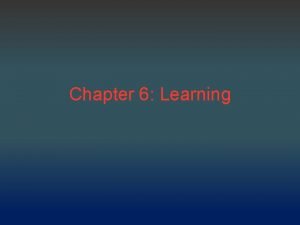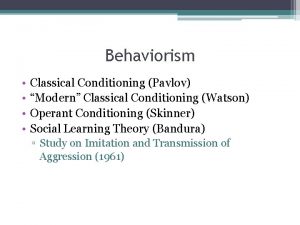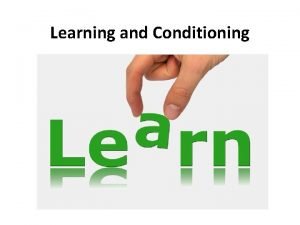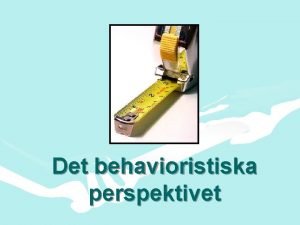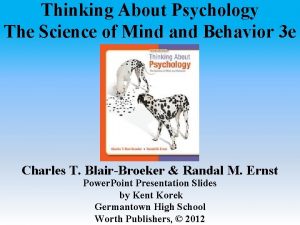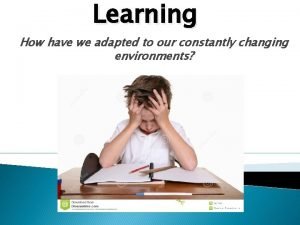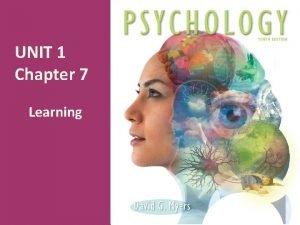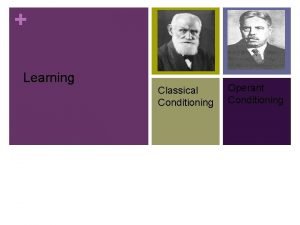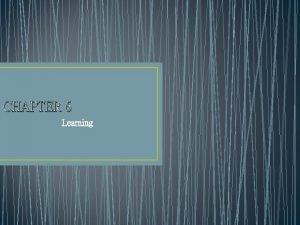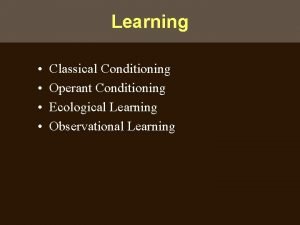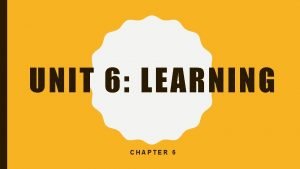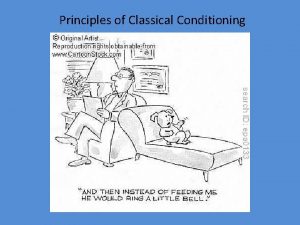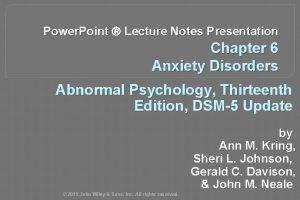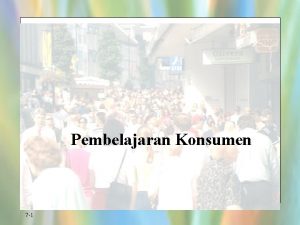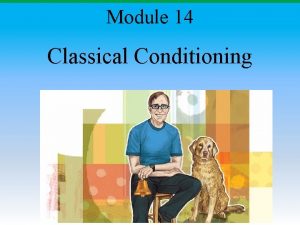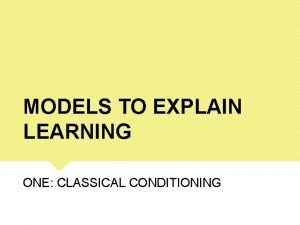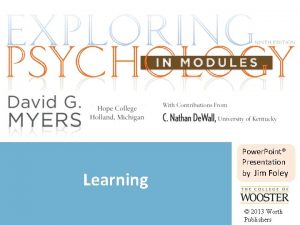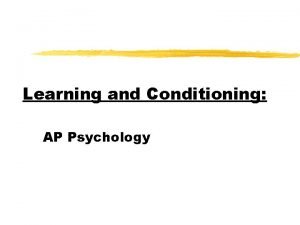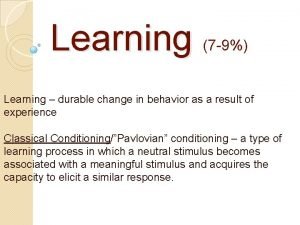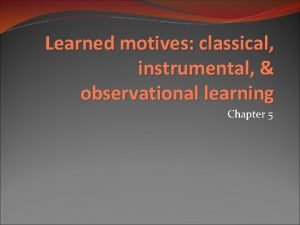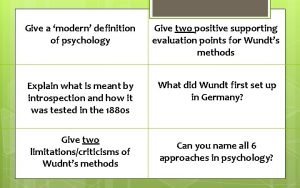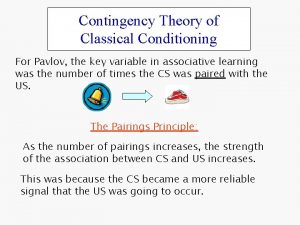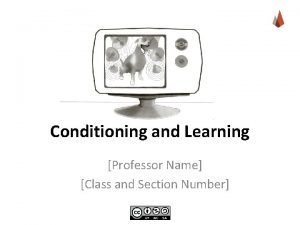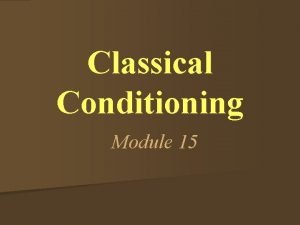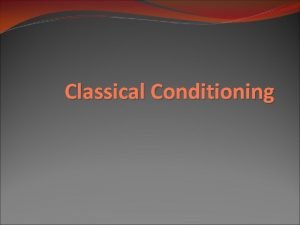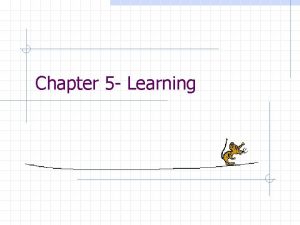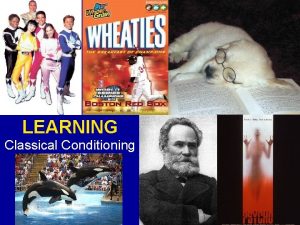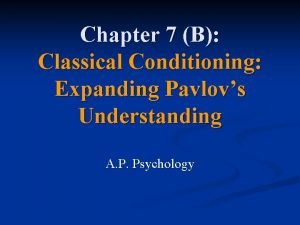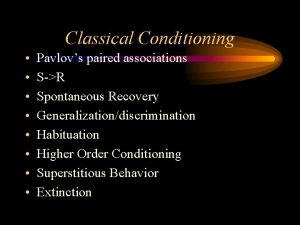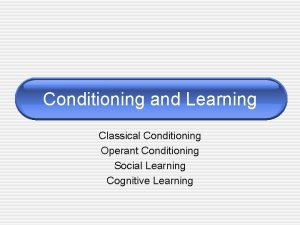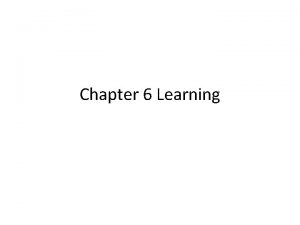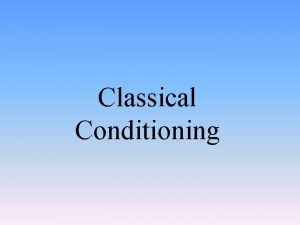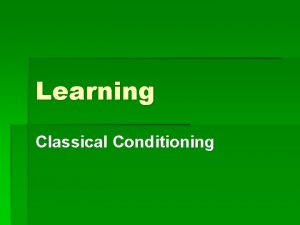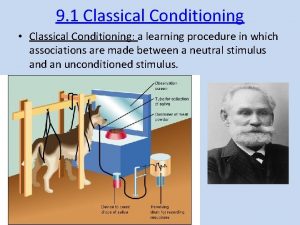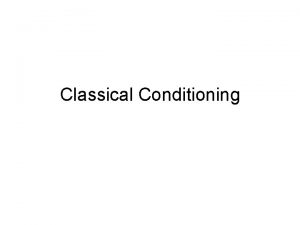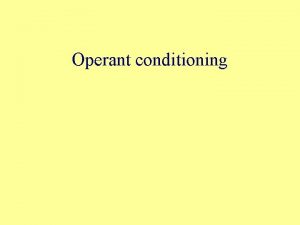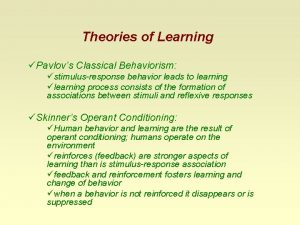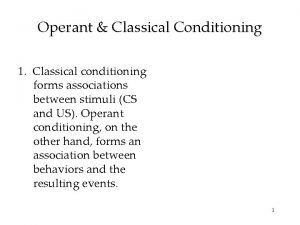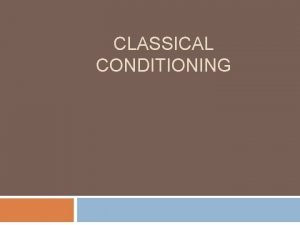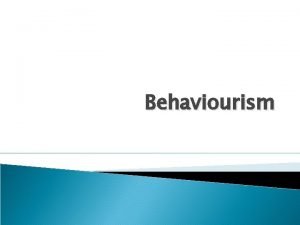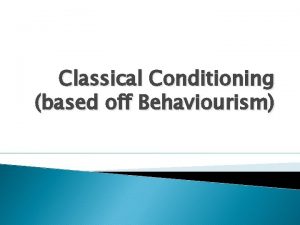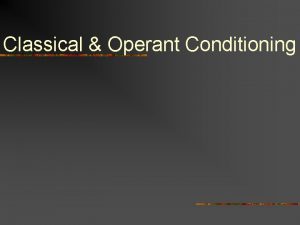LEARNING Chapter 8 CLASSICAL CONDITIONING Classical Conditioning Pavlovs



































- Slides: 35

LEARNING Chapter 8

CLASSICAL CONDITIONING

Classical Conditioning – Pavlov’s Experiment Ivan Pavlov - Russian physiologist, who in the 1900’s, discovered the principle of classical conditioning by studying the effects of digestion. Classical Conditioning - a type of learning in which a neutral stimulus triggers a response after being paired with another stimulus that naturally triggers that response.

Before conditioning: • Neutral Stimulus: (tuning fork) Nothing to do with the response to food • Unconditioned Stimulus: (food) A stimulus that naturally and automatically triggers an unconditioned response. • Unconditioned Response: (salivation) The unlearned, automatic response to an unconditioned stimulus.

Once conditioning is complete: • Conditioned Stimulus: (tuning fork) A once neutral event that has come to elicit a given response. • Conditioned Response: (salivation) Learned response to a previously neutral conditioned stimulus. • Note - Conditioning is most reliable and effective when the conditioned stimulus was presented about a half second before unconditioned stimulus.

General Principles of Classical Conditioning • Generalization: The tendency, once a response has been conditioned, for stimuli similar to conditioned stimulus to elicit similar responses (ex. circles & ovals) • Discrimination: The ability to distinguish between a conditioned stimulus and similar stimuli that do not signal an unconditioned response. (ex. circle vs. oval)

General Principles of Classical Conditioning • Extinction – the gradual disappearance of a conditioned response because the reinforcement is withheld or because the conditioned stimulus is repeated presented without the unconditioned stimulus. • Spontaneous Recovery – the reappearance of an extinguished conditioned response after a pause

Classical Conditioning & Human Behavior • J 0 hn Garcia showed that aversion or dislike for a food can be conditioned (rats & radiation) • Taste aversion - a learned response to eating spoiled or toxic food. When taste aversion takes place, you avoid eating the foods that make you ill. – Used in a study to keep coyotes away from sheep • Classical conditioning provides information that is helpful to survival • Helps to predict what is going to happen

The Case of Little Albert • John B. Watson and his assistant Rosalie Rayner showed how fear could be conditioned. • The experiment was done at Johns Hopkins University in 1920. • Controversial – They did not extinguish Albert’s fear when the experiment was done

OPERANT CONDITIONING

Operant Conditioning • Behavior is strengthened if followed by a reinforcer or diminished if followed by a punisher. (Rewards & Punishments) • Classical conditioning involves respondent behavior – occurs as an automatic response to some stimulus • Operant conditioning involves operant behavior – behavior that operates on the environment to produce rewarding or punishing stimuli (Involves learned associations between its behavior & resulting events)

B. F. Skinner • Behaviorism’s most influential and controversial figure • Based on E. L. Thorndike’s law of effect – idea that rewarded behavior is more likely to be repeated (Cat in a puzzle box ) • Believed that operant conditioning required a subject to manipulate or operate within the environment • Operant Chamber (Skinner Box) – box with a bar or key that an animal presses or pecks to release a reward of food or water and a measuring device to record responses

B. F. Skinner Shaping – reinforcers, such as food, gradually guide an animal’s actions toward a desired behavior Successive approximations – reward responses that are ever-closer to the final desired behavior, and ignore all other responses

Principles of Reinforcement • Reinforcement – any event that strengthens or increases the frequency of a behavior it follows (vary with circumstance) • Two basic types – Positive & Negative (both increase behavior) • Positive Reinforcement – (appetitive stimulus) Strengthens a response by presenting a typically pleasurable or desired stimulus after a response • Food for a hungry animal • Money (for most people)

Principles of Reinforcement • Primary Reinforcers – (innate) satisfy a biological need (food, water) • Secondary Reinforcers (conditioned reinforcers) – learned stimulus that gets its power through association with primary reinforcers (money, good grades, praise, smiles) • Humans do respond to reinforcers that are greatly delayed • Part of maturing is learning to delay gratification in order to achieve more valued rewards – Marshmallow test

Principles of Reinforcement Premack Principle – a person will perform a less desirable activity in order to perform the more desirable activity as a consequence • The more probable behavior becomes a reinforcer for a less probably one – Examples: • Eat your dinner and you can have ice cream • Wash the dishes and you can watch TV • Come to class and complete all of your week and you can be exempt from exams •

Principles of Reinforcement • Negative Reinforcement – Strengthens a response by reducing or removing an undesirable (aversive) stimulus – This is NOT PUNISHMENT • Aspirin for a headache • Turn off the alarm to stop annoying noise

Principles of Reinforcement Aversive Conditioning – learning involving an unpleasant or harmful stimulus or reinforcer Two types of learning within negative reinforcement: • Escape learning – an organism learns to perform an operation to terminate an ongoing, aversive stimulus • EX. a dog gets shocked and then he escapes it by jumping over the hurdle • Avoidance learning – an organism learns that it can altogether avoid a negative stimulus by making a particular action before it even begins • Ex. a dog jumps over a hurdle to avoid an electric shock

Principles of Reinforcement • Learned Helplessness – the feeling of futility and passive resignation that results from the inability to avoid repeated aversive events. • Later, if it becomes possible to avoid or escape the aversive stimulus, it is unlikely that the learner will respond. They have learned that, regardless of their actions, they have no ability to change the outcome.

Reinforcement Schedules • Continuous reinforcement – reinforcing the desired response every time it occurs (Learning occurs rapidly) • Partial (Intermittent) reinforcement - responses are sometimes reinforced and sometimes not • Produces greater persistence and greater resistance to extinction • 4 types of partial reinforcement

Partial Reinforcement Schedules • Ratio schedules are based the number of behaviors being performed • Fixed-Ratio Schedules – reinforce behavior after a set number of responses • Factory worker gets paid every 30 pieces • Kohls cash • Variable-Ratio Schedule – reinforced after an unpredictable number of responses (produces higher rates of responding) • Gambling or Fishing • Graded assignments

Partial Reinforcement Schedules Interval schedules are based on the amount of time elapsed • Fixed Interval Schedule – reinforces a response only after a specified amount of time has elapsed (produces a choppy startstop pattern) • Get paid every two weeks • End of the card marking every 10 weeks • Variable-Interval Schedule - reinforces a response at unpredictable time intervals (produce slow, steady responding) • • • Someone responds to your social media post Variable schedules produce more consistent responding

Fixed Schedules – predictable Variable Schedules unpredictable • Fixed Ratio – reinforcement • Variable Ratio – reinforcement • Fixed Interval – reinforcement • Variable Interval – after a fixed or set number of responses of first response after a fixed amount of time has passed after a varying number of responses reinforcement of first response after varying amounts of time

Punishment • Punishment – decreases the behavior that it follows, usually by administering an undesirable consequence or withdrawing a desirable one • Positive Punishment – give something the subject doesn’t like in order to remove or decrease the behavior • A parking ticket; a time out for child; a detention • Negative Punishment – remove or take away something desirable to the subject • Ex. Take a phone away; no television; car keys

Reinforcement = give something to increase behavior • Positive - give reward, something pleasurable (+) • Negative - removal unwanted stimulus to strengthen behavior (-) Punishment = undesirable event to decrease or stop behavior • Positive – give something undesirable (+) • Negative = take away something desirable (-)

Negatives of Using Punishment • Punished behavior is just suppressed, not forgotten • Punishment teaches discrimination – Child won’t stop cussing, just learns to discriminate and not cuss near mom • Punishment can teach fear – may lead to avoidance • Physical punishment may increase aggression – punisher models aggressive behavior

Cognition and Operant Conditioning • Skinner discounted the importance of cognition & biological predispositions. • Through evolution, animals are biologically predisposed to easily learn behaviors related to their survival as a species. Behaviors contrary to an animal’s natural tendencies are learned slowly or not at all. • Instinctive drift – a conditioned response that drifts back toward the natural (instinctive) behavior of the organism

Cognition and Operant Conditioning • Critics - There is more to learning than response & consequence; cognition is at work • Edward Tolman - Rats explored maze for 10 days, then rewarded, finished as quickly as rats who received reinforcers • Latent learning - learning that occurs but is not apparent until there is an incentive to demonstrate it later. • Learning can take place without the presence of a reinforcer • Cognitive Map - a mental representation of the layout of one’s environment.

Cognition and Operant Conditioning • More evidence: promising a reward for a task you already enjoy may backfire • Children promised money for playing with a toy later play with it less than unpaid children • Intrinsic Motivation - a desire to perform a behavior effectively for its own sake. • Extrinsic Motivation - a desire to perform a behavior to receive promised rewards or avoid threatened punishment.

Learning - The process by which experience or practice results in a relatively permanent change in behavior or potential behavior Classical Conditioning The type of learning in which a response naturally elicited by one stimulus becomes to be elicited by a different formally neutral stimulus Operant Conditioning The type of learning in which behaviors are emitted to earn rewards or avoid punishments Social Cognitive Learning Theory The type of learning in which behaviors are learned by observing a model Pavlov and Watson B. F. Skinner Albert Bandura UCS, UCR, CS, CR Reinforcement and Punishment Modeling and Vicarious Learning

Learning by Observation • Observational learning - learning by observing & imitating others. Also called social learning. • Modeling - the process of observing and imitating a specific behavior.

Learning by Observation • Mirror neurons - frontal lobe neurons that fire when performing certain actions or when observing another doing so. The brain’s mirroring of another’s action may enable imitation and empathy. • Our brain generates an inner simulation, enabling us to experience the other’s experience within ourselves • Theory of mind – mirror neurons help children have empathy & to infer other’s mental states

Learning by Observation • Albert Bandura – pioneer researcher in observational learning • Bandura’s Bobo Doll Experiment – We look and we learn

Applications of Observational Learning • Antisocial effects – Observational learning can have negative effects – We can mirror antisocial behavior • Prosocial effects – Positive, constructive, helpful behavior can be modeled by others • We are especially likely to imitate people we perceive as similar to ourselves, as successful, or as admirable • Parents are powerful models

Television and Observational Learning • Correlational evidence shows that observing violence is associated with violent behavior. • BUT correlation is not causation • Experimental evidence also shows that viewers of media violence can experience desensitization – a reduction in emotional arousal and distress when observing violent acts.
 Difference between classical and operant conditioning
Difference between classical and operant conditioning Classical conditioning and operant conditioning
Classical conditioning and operant conditioning Three-phase model of operant conditioning
Three-phase model of operant conditioning Classical conditioning vs operant
Classical conditioning vs operant Operant vs classical
Operant vs classical Classical and operant conditioning.
Classical and operant conditioning. Secondary reinforcer psychology definition
Secondary reinforcer psychology definition Operant and classical conditioning
Operant and classical conditioning Classical conditioning vs operant conditioning
Classical conditioning vs operant conditioning Operant conditioning classical conditioning
Operant conditioning classical conditioning Behaviorismen
Behaviorismen Ivan pavlov classical conditioning
Ivan pavlov classical conditioning Little albert classical conditioning
Little albert classical conditioning Second-order conditioning examples
Second-order conditioning examples Jeopardy pavlovs
Jeopardy pavlovs Instrumental learning vs classical conditioning
Instrumental learning vs classical conditioning Instrumental learning vs classical conditioning
Instrumental learning vs classical conditioning Social learning theory vs operant conditioning
Social learning theory vs operant conditioning Cuadro comparativo entre e-learning b-learning y m-learning
Cuadro comparativo entre e-learning b-learning y m-learning Little albert experiment summary
Little albert experiment summary Order of classical conditioning
Order of classical conditioning Classical conditioning panic disorder
Classical conditioning panic disorder Contoh iklan classical conditioning
Contoh iklan classical conditioning Classical conditioning cs us ur cr
Classical conditioning cs us ur cr Classical conditioning little albert
Classical conditioning little albert Generalization classical conditioning
Generalization classical conditioning Ivan pavlov classical conditioning
Ivan pavlov classical conditioning Neutral stimulus becomes a conditioned stimulus
Neutral stimulus becomes a conditioned stimulus Classical conditioning ap psychology
Classical conditioning ap psychology Classical conditioning generalization
Classical conditioning generalization Learned motives
Learned motives John b watson experiment
John b watson experiment What is classical conditioning example
What is classical conditioning example Behaviorism
Behaviorism Real life example of classical conditioning
Real life example of classical conditioning Garcia effect
Garcia effect







